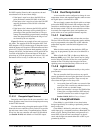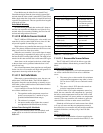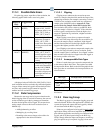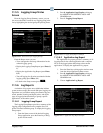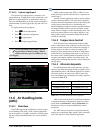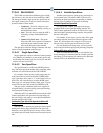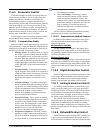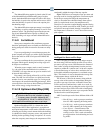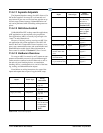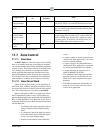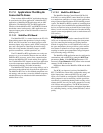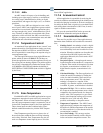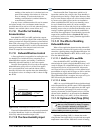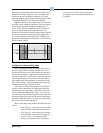
11-22 • E2 RX/BX/CX I&O Manual 026-1614 Rev 4 5-JAN-2013
11.6.5 Economizer Control
Economizer dampers on AHUs are used to bring out-
side air into the building for use in cooling. When tem-
perature and humidity conditions are favorable, the
economization dampers are opened, and outside air is
allowed to flow into the AHU. Economization is generally
used by the AHU just as a cool stage would be in Tem
-
perature Control; if cooling is needed, and conditions are
favorable for economization, the dampers will open and
economization will begin. If more cooling is needed, the
cooling stages would then cycle on as normal.
The E2 supports control of both two-position (digital)
and variable-position (analog) economizer dampers.
11.6.5.1 Economization Enable
Before the AHU Control application may open econo-
mization dampers, it must first determine if the outdoor air
conditions are favorable for economization. There are six
possible ways the AHU Control may do this:
1. Enthalpy Switch - An enthalpy switch is a digital
device that is pre-set to detect when the tempera
-
ture and humidity levels are favorable for econo-
mization. When the conditions are favorable, this
switch sends an OK (ON) signal to the AHU
Control application. Otherwise, the switch sends
a NOT OK (OFF) signal, and economization is
disabled.
2. Dewpoint Setpoint - A dewpoint probe measur-
ing the dewpoint of the outside air is compared to
a setpoint. If the outside air dewpoint is less than
the setpoint, economization is enabled. If it is
higher than the setpoint, economization is dis
-
abled.
3. Calculated Enthalpy - The AHU Control appli-
cation calculates the outside air enthalpy by read-
ing the value of a relative humidity sensor and an
outdoor air temperature sensor. If the enthalpy is
lower than the setpoint, economization is
enabled. If the enthalpy is greater than the set
-
point, economization is disabled.
4. Dewpoint Fail-Safe - This is similar to method
#2, except an outdoor temperature sensor value is
compared to the setpoint instead of a dewpoint
probe’s value. This comparison is a poor substi
-
tute for actual dewpoint readings and is recom-
mended for use as a fail-safe only. When
possible, use humidity or dewpoint sensors.
5. Temperature Comparison - The AHU Control
application simply compares the temperature of
the inside air with the temperature of the outside
air. If the outside air is cooler than the inside air,
economization is enabled.
6. In vs. Out Enthalpy - This strategy requires
indoor and outdoor humidity sensors and also
indoor and outdoor temperature sensors. The
enthalpy of the outdoor air is calculated and com
-
pared to the enthalpy of the indoor air. If the out-
door air enthalpy is less than the indoor air
enthalpy, economization is enabled. Otherwise,
economization is disabled.
You may choose a different economization checking
method for use in summer and winter months.
11.6.5.2 Economization Lockout Features
In addition to the methods listed above, there are two
economization lockout features that apply to all AHUs
using economization.
Max Outside Air Humidity
The Max Outside Air Humidity is the highest allow-
able humidity level for the outside air. If the outside rela-
tive humidity is higher than this setpoint, economization
will not be allowed to occur.
Minimum Supply Temp
The Minimum Supply Temp is a user-defined setpoint
that locks out economization if the supply air temperature
falls below a minimum supply temperature setpoint. This
feature ensures that the air coming from outside is not too
cold.
11.6.6 Digital Economizer Control
Control of digital or two-position economizers is rela-
tively simple. When conditions are favorable for econo-
mization, the dampers will be opened when cooling is
needed. If not favorable, the dampers will be closed.
11.6.7 Analog Economizer Control
For variable-position dampers, economization is gen-
erally used by the AHU just as a cool stage would be in
Temperature Control. If cooling is needed, and conditions
are favorable for economization, the dampers will open
and economization will begin. If more cooling is needed,
the cooling stages would then cycle on as normal.
The position of the analog economizer damper is
important only for the purposes of keeping the mixed air
temperature (a combination of the outdoor air coming
through the dampers and the return air temperature) near
the user-specified setpoint. The damper is controlled using
PID control.
11.6.8 Dehumidification Control
Dehumidification control uses the AHU’s existing cool
stages (and a separate dehumidification device such as a
desiccant wheel, if available) to remove moisture from the



